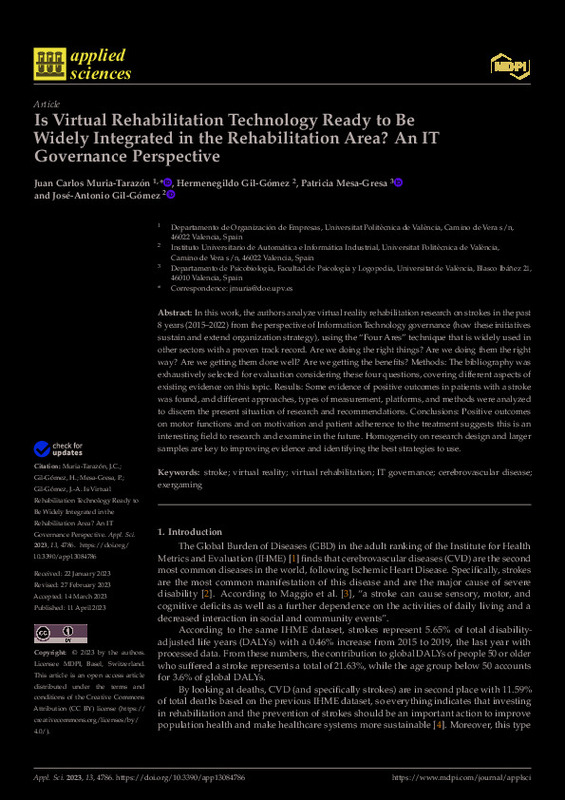JavaScript is disabled for your browser. Some features of this site may not work without it.
Buscar en RiuNet
Listar
Mi cuenta
Estadísticas
Ayuda RiuNet
Admin. UPV
Is Virtual Rehabilitation Technology Ready to Be Widely Integrated in the Rehabilitation Area? An IT Governance Perspective
Mostrar el registro sencillo del ítem
Ficheros en el ítem
| dc.contributor.author | Muria-Tarazón, Juan Carlos
|
es_ES |
| dc.contributor.author | Gil Gómez, Hermenegildo
|
es_ES |
| dc.contributor.author | Mesa-Gresa, Patricia
|
es_ES |
| dc.contributor.author | Gil-Gómez, José-Antonio
|
es_ES |
| dc.date.accessioned | 2024-01-10T19:02:58Z | |
| dc.date.available | 2024-01-10T19:02:58Z | |
| dc.date.issued | 2023-04 | es_ES |
| dc.identifier.uri | http://hdl.handle.net/10251/201731 | |
| dc.description.abstract | [EN] In this work, the authors analyze virtual reality rehabilitation research on strokes in the past 8 years (2015-2022) from the perspective of Information Technology governance (how these initiatives sustain and extend organization strategy), using the "Four Ares" technique that is widely used in other sectors with a proven track record. Are we doing the right things? Are we doing them the right way? Are we getting them done well? Are we getting the benefits? Methods: The bibliography was exhaustively selected for evaluation considering these four questions, covering different aspects of existing evidence on this topic. Results: Some evidence of positive outcomes in patients with a stroke was found, and different approaches, types of measurement, platforms, and methods were analyzed to discern the present situation of research and recommendations. Conclusions: Positive outcomes on motor functions and on motivation and patient adherence to the treatment suggests this is an interesting field to research and examine in the future. Homogeneity on research design and larger samples are key to improving evidence and identifying the best strategies to use. | es_ES |
| dc.language | Inglés | es_ES |
| dc.publisher | MDPI AG | es_ES |
| dc.relation.ispartof | Applied Sciences | es_ES |
| dc.rights | Reconocimiento (by) | es_ES |
| dc.subject | Stroke | es_ES |
| dc.subject | Virtual reality | es_ES |
| dc.subject | Virtual rehabilitation | es_ES |
| dc.subject | IT governance | es_ES |
| dc.subject | Cerebrovascular disease | es_ES |
| dc.subject | Exergaming | es_ES |
| dc.subject.classification | LENGUAJES Y SISTEMAS INFORMATICOS | es_ES |
| dc.subject.classification | ORGANIZACION DE EMPRESAS | es_ES |
| dc.title | Is Virtual Rehabilitation Technology Ready to Be Widely Integrated in the Rehabilitation Area? An IT Governance Perspective | es_ES |
| dc.type | Artículo | es_ES |
| dc.identifier.doi | 10.3390/app13084786 | es_ES |
| dc.rights.accessRights | Abierto | es_ES |
| dc.contributor.affiliation | Universitat Politècnica de València. Escuela Técnica Superior de Ingenieros Industriales - Escola Tècnica Superior d'Enginyers Industrials | es_ES |
| dc.contributor.affiliation | Universitat Politècnica de València. Escuela Técnica Superior de Ingenieros de Telecomunicación - Escola Tècnica Superior d'Enginyers de Telecomunicació | es_ES |
| dc.description.bibliographicCitation | Muria-Tarazón, JC.; Gil Gómez, H.; Mesa-Gresa, P.; Gil-Gómez, J. (2023). Is Virtual Rehabilitation Technology Ready to Be Widely Integrated in the Rehabilitation Area? An IT Governance Perspective. Applied Sciences. 13(8). https://doi.org/10.3390/app13084786 | es_ES |
| dc.description.accrualMethod | S | es_ES |
| dc.relation.publisherversion | https://doi.org/10.3390/app13084786 | es_ES |
| dc.type.version | info:eu-repo/semantics/publishedVersion | es_ES |
| dc.description.volume | 13 | es_ES |
| dc.description.issue | 8 | es_ES |
| dc.identifier.eissn | 2076-3417 | es_ES |
| dc.relation.pasarela | S\487983 | es_ES |
| dc.subject.ods | 03.- Garantizar una vida saludable y promover el bienestar para todos y todas en todas las edades | es_ES |








